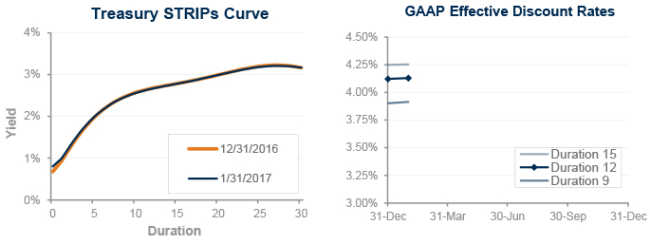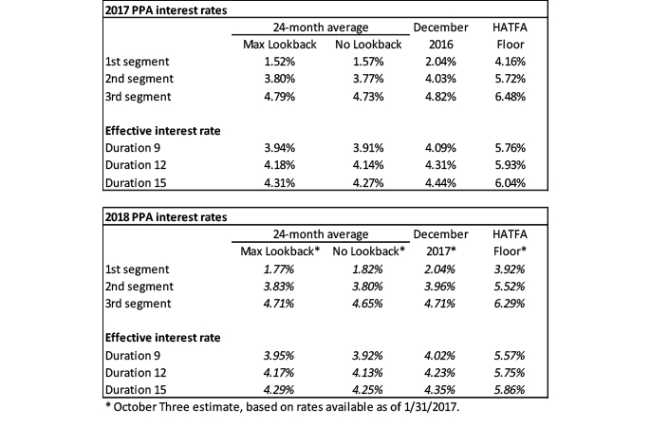January 2017 Pension Finance Update
Pension sponsors enjoyed a modest boost in January on the strength of higher stock markets and steady interest rates during the month. Both model pension plans we track1 were up last month: Plan A gained a bit more than 1%, while Plan B gained less than 1%:

Assets
Equity markets gained ground in January: the S&P 500 was up 2%, the NASDAQ gained more than 4%, the overseas EAFE index added more than 3%, and the small-cap Russell was up less than 1%.
A diversified stock portfolio gained more than 2% in January.
Bonds gained a fraction of 1%, as interest rates didn’t change much in January.
Overall, our traditional 60/40 gained a bit more than 1% in January, while the conservative 20/80 portfolio was up less than 1% for the month.
Liabilities
Pension liabilities (for funding, accounting, and de-risking purposes) are now driven by market interest rates. The graph on the left compares Treasury STRIPs yields at December 31, 2016, and January 31, 2017. The graph on the right shows our estimate of movements in effective GAAP discount rates for pension obligations of various duration during 2017:

Both Treasury and corporate bond yields ended the month almost exactly where they began it.
As a result, pension liabilities increased by a fraction of 1% during January.
Summary
In the previous two years, pension sponsors suffered substantial drops in funded status in January and spent much of the year trying to climb out of the hole. Modest improvement in January 2017 is a welcome change.
The graphs below show the movement of assets and liabilities for our two model plans:

Looking Ahead
Congress passed a budget in 2015 that includes a third round of pension funding relief since 2012. The upshot is that pension funding requirements over the next several years will not be appreciably affected by current low interest rates (unless these rates persist). Required contributions for the next few years will be lower and more stable than under prior law.
Discount rates were basically unchanged last month. We expect most pension sponsors will use effective discount rates in the 3.8%-4.4% range to measure pension liabilities right now.
The table below summarizes rates that plan sponsors are required to use for IRS funding purposes for 2017, along with estimates for 2018. Pre-relief, both 24-month averages and December ‘spot’ rates, which are still required for some calculations, such as PBGC premiums, are also included.

1Plan A is a traditional plan (duration 12 at 5.5%) with a 60/40 asset allocation, while Plan B is a cash balance plan (duration 9 at 5.5%) with a 20/80 allocation with a greater emphasis on corporate and long-duration bonds. We assume overhead expenses of 1% of plan assets per year, and we assume the plans are 100% funded at the beginning of the year and ignore benefit accruals, contributions, and benefit payments in order to isolate the financial performance of plan assets versus liabilities.
